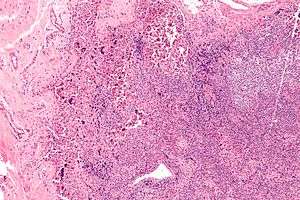Generalized lymphadenopathy
| Generalized lymphadenopathy | |
|---|---|
 | |
| Lymphadenopathy due to systemic lupus erythematosus with characteristic necrosis and haematoxylin bodies. H&E stain. | |
| Classification and external resources | |
| ICD-10 | R59.1 |
Lymph nodes or 'glands' or nodes or lymphoid tissue are nodular bodies located throughout the body but clustering in certain areas such as the armpit, back of the neck and the groin. They are part of the lymphatic system.
The lymphatic system is part of the body's immune surveillance system. Blood contains fluid and blood cells. The fluid, which may contain suspended foreign material such as bacteria and viruses, seeps through blood vessel walls into the tissues, where it bathes the body cells and exchanges substances with them. Some of this fluid is then taken up by lymphatic vessels and passed back to the heart, where it is again mixed with the blood. On its way the fluid passes through the lymph nodes. If nodes detect something foreign passing through them such as a bacterium or a cancer cell they will swell up. This is called lymphadenopathy or swollen glands. Usually this is localised (for example an infected spot on the scalp will cause lymph nodes in the neck on that same side to swell up), but when it is in two or more regions, it is called generalized lymphadenopathy.[1]
Usually this is in response to a body-wide infectious disease such as influenza and will go away once the person has recovered, but sometimes it can persist long-term, even when there is no obvious cause of disease. This is then called persistent generalized lymphadenopathy (PGL).
Causes of generalized lymphadenopathy
- Infection :
- Viral : Infectious mononucleosis, Infective hepatitis, AIDS
- Bacterial : Tuberculosis, Brucellosis, secondary syphilis, Tularemia
- Protozoal : Toxoplasmosis
- Fungal : Histoplasmosis
- Malignant :
- Immunological :
- Systemic lupus erythematosus
- Felty's syndrome
- Still's disease
- Drug hypersensitivity as Hydantoin, Hydralazine, Allopurinol
- Misc. :